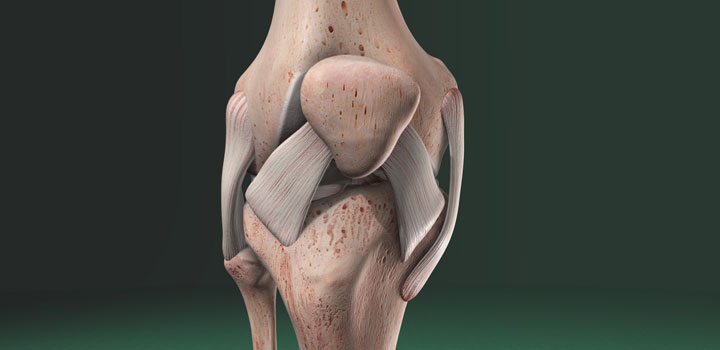About the Knee and Knee Replacement
Knee Anatomy
The knee is a complicated joint which is made up of muscle, tendons, ligaments, and bones. These components permit it to move in a number of directions enabling us to sit, stand, walk, climb stairs, and change direction (pivot).
There are three bones: the femur (thigh bone), the tibia (shin bone), and the patella (knee cap). The surface of the ends of these bones is covered in cartilage. A cartilage pad, called the meniscus, sits between the femur and the tibia.
The entire joint is bathed in a slippery fluid – synovial fluid – which lubricates the joint and also supplies the cartilage with nutrients.
The knee can be damaged by trauma (for example, falls, sports injuries, car accidents) or through disease such as with arthritis. Following trauma or disease, the articular cartilage wears away and raw bone begins to rub against raw bone. Once enough damage has occurred, the knee becomes painful and causes discomfort, limping, instability, giving way, and swelling, resulting in a decrease in the motion and function of the knee joint.
What is Knee Replacement?
Knee Replacement is a surgical procedure — performed in the US since the 1960s — which involves the replacement of diseased, damaged, and worn-out parts of the knee with an artificial joint called a prosthesis. Made of metal alloys and high-grade plastics (which are intended to mimic the function of bone and cartilage, respectively), the prosthesis is designed to move just like a healthy human joint.
A total knee replacement implies that everything about the joint is being replaced – which isn’t true. What is actually being done is just a resurfacing of the bones of the joint. The prosthesis that is used is made up of plastic and metal and is placed on the joint surface of each bone. Most of the ligaments and all of the tendons remain intact. This allows the bones to glide against each other and allow the knee to bend and move without pain.
Why Knee Replacement?
It is important for you to realize that this is an elective surgical procedure which means that you have to choose it. It’s not absolutely essential, although almost certainly you would be improved by it as long as there are no major complications. The reason for this report is to provide you with the kind of information as well as answers to some typical questions that will help you make that decision.
Once the knee is damaged to the point that it is painful or that it can no longer move in the way that it is intended, the patient goes to a physician to see if anything can be done to change this situation.
There are things that can be done other than knee replacement for people who have problems with their knees. Whether those things are likely to be successful, depends a little bit on the specific individual circumstances.
One of the alternatives to total knee replacement, of course, is to do nothing, simply to continue with your present disability and your present discomfort and modifying those, if possible, with:
- physical therapy
- anti-inflammatory medications and pain medications
- restricting your activities using a cane or crutches
- injections of Cortisone or Visco Supplementation (i.e. Synvisc, Euflexxa, Hyalgan)
Depending on the stage of your disease or damage, total joint replacement may be the only reasonable surgical procedure. This means that basically the choice is either to proceed with a total joint replacement or simply to wait a little bit longer to see how rapidly your condition deteriorates and to try some other things including medication, limitation of activity, weight reduction, etc.
What should you expect?
Blood Transfusion
Many patients who have a knee replacement will require blood transfusion. If you are donating blood for your surgery, you will be asked to donate one or two units of your own blood within 35 days prior to your surgery date. This will involve scheduling an appointment with the blood bank of the hospital, or if necessary, a blood donation facility recommended by your insurance carrier or one closer to where you live (for out-of-state patients). Only one unit of blood can be donated at a time, so you may need to come in for two visits. The blood is then stored until your operation.
If you are unable to donate blood, for whatever reason, donor blood will be used in your case, if necessary. People have expressed some concern about blood transfusion because of the risk of transmitting diseases. Donor blood is carefully screened for communicable diseases. With the new technology, the risk of hepatitis and HIV infection is extremely low. To our knowledge, disease transmission through use of donated blood has never occurred in any of our patients. However, there is no question that your own blood is the safest. Therefore, if you are able, we recommend that you donate blood for your surgery. If you’re coming a long way, arrangements can be made to have you give blood locally and have it transported here for your surgery. Please be assured that blood that you give will be given back to you, if needed.
Pre-admission Testing
Within two weeks prior to your surgery, you will be asked to undergo several laboratory tests and possibly an electrocardiogram and chest x-ray. This is called pre-admission testing. This will help us to tell whether there are any conditions which might increase the risk of surgery. A physical examination, performed by your own medical doctor or hospital staff here, is also a part of pre-admission testing.


